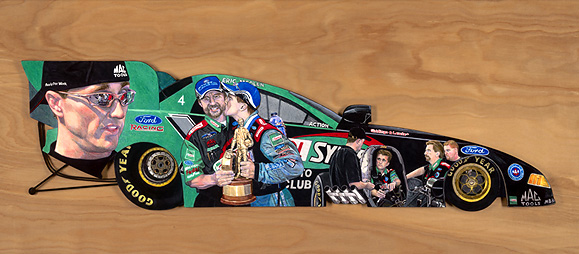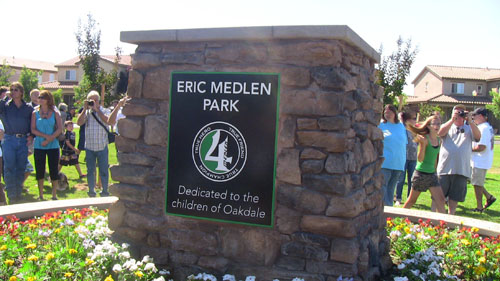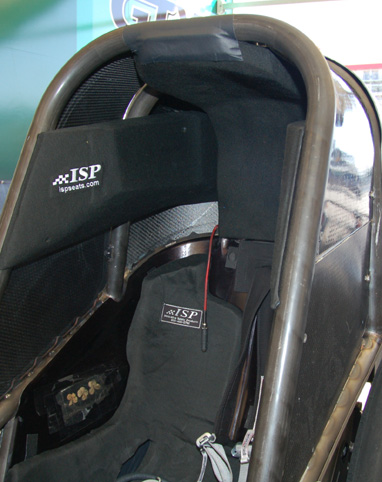AUSTIN COIL: ERIC MEDLEN SACRIFICED HIS LIFE TO MAKE FUNNY CARS SAFER


Austin Coil's career in drag racing spanned a short 17,108 days, give or take a dozen or so leap years. In this time, he's had some memorable days and some forgetful moments.
March 19, 2007, is one day Coil can never forget.
The Monday following the 2007 NHRA Gatornationals, Coil's life, and Funny Car drag racing would never be the same. On this day, Eric Medlen, one of drag racing's shining stars and Coil's close friend, a racer many years his junior, was critically injured when a tire failed forcing his Funny Car into such severe tire shake that he sustained irreparable brain damage. He died four days later from his injuries.
Coil didn't witness the incident, and he's glad he didn't. The aftermath provides more flashbacks for the seasoned drag racing veteran than he cares to remember.
Little did Coil know the day would inspire him to repeat one his more common quotes, over and over.
"There is probably no truer adage surrounding motorsports in general than the old saying of, ‘All safety rules are written in blood," Coil repeated in a somber tone.
Coil never believed one day his words would be proven true by a youthful driver he described as one of the most inspirational drivers he's ever met.
Coil's painful day started with no indication a tragedy was looming on the horizon. Monday was just another day at the Monday Morning Nationals, another term for the day after the national event where teams usually tested to solve issues from the just-completed weekend.
John Force Racing hadn't experienced a particularly successful Sunday in Gainesville, patriarch John Force lost in the first round to Medlen. Both Medlen and Ashley Force were disqualified when their cars crossed the outer boundary. Robert Hight lost in the second round as well.
Coil remembers John had just made a run, and Medlen was behind him to run a few cars later. Just as he had returned to the pits, he heard the launch of Medlen's car, and shortly afterward the sound went silent.
Coil was already immersed in the data of Force's run when he heard chatter on the radio, and there was a chance Medlen had been injured.
"My first inclination was, ‘Well, things go wrong on these cars, bump the guardrail and stuff like that happens all the time," Coil recalled. "Nobody ever gets hurt, so I wasn’t immediately concerned at all. And then I heard one of the crew men’s voices on the radio calling out to John Medlen, ‘You’ve got to come here quick. Eric’s hurt real bad I think."
At this moment, Coil said his heart dropped.
"I looked around, and at that time, all of the pit scooters and stuff were gone," Coil explained. "And with my back troubles, I can’t run very far to get out there. So it’s like I thought, ‘Well you know I’ll find out some more here in a minute."
"By the time the next bit of information I had got, there was a helicopter coming in to take Eric away."
 For nearly two decades at the time Coil had watched his boss at any given time walk away from accidents where his car had been on fire, upside down and any other gyration a race car could make.
For nearly two decades at the time Coil had watched his boss at any given time walk away from accidents where his car had been on fire, upside down and any other gyration a race car could make.
Coil then took the data from Medlen's crashed race car, and while he looked over the numbers, and realized his team's driver was still unconscious, the magnitude of the situation hit him like a ton of bricks.
"It was like ‘Oh my God, this is serious," Coil admitted. "We were trying to figure out what happened there. Something made the tire fail, and the car had shook pretty hard."
Back at the shop, Coil recalled, there were clues which stood out significantly.
"The chassis had cracked up by the engine, and had broken off one of the frame rails," Coil said. "Two of the frame rails were cracked really severely. The drive shaft had come out. You know, we went through an awful lot of evaluation as we tried to figure out which came first.
"Finally after due evaluations, what we came to the conclusion was is that a tire blew up and we weren’t probably ever 100-percent sure what caused the tire to fail. But nonetheless, that happened.
"Some of our associates at Ford brought up the point, you know, race cars have tire failures. And it’s your duty to build a race car to where when a tire fails, you can protect the driver."
With Medlen's father John Medlen taking the lead, Coil joined in with a team which included noted racecar driver safety specialist Dr. John Melvin, Murf McKinney and a score of highly qualified specialists working on a goal to ensure Funny Car drivers would be better protected from this point on.
The first priority was to improve the Funny Car cockpit safety.
Melvin, who had worked closely with NASCAR following Dale Earnhardt's tragic death, suggested the best immediate solution was to give the roll cage as much room around the driver, around the driver’s head, as could fit in the cars. The Funny Cars needed immediately better head pads, which would provide the best cushioning for this type of impact.

Before Medlen's accident, the Funny Car chassis configurations hadn't been subjected to any major reconfiguration in almost three decades.
"What we saw, in looking over the race cars, is that a lot of people had the bare minimum of head pads, restraints, padding, and so forth that was required by the rules," Coil explained. "And so, you know, as far as we were concerned, well we had our own rules. We did not attend the next race because we had to figure out something that would make a reasonable difference."
Coil remembers watching the roll cages made bigger, the addition of head pads and now poured seats for the drivers.
"What Dr. Melvin brought to the picture was the knowledge that the driver being really firmly attached to the car so that he cannot wiggle at all is probably more important than the head pads," Coil said. "Because if the driver can move around in the seat, well then his neck becomes a fishing pole to whiplash his head around against the padding. And so having a poured seat that was common in the Indy car racing and things like that, for a long, long time. We did that and we installed the seven-point belts with very accurate attention to where the mounting points are."
Coil remembered that before the incident, many of teams had installed their seats and seat belts according to their driver's comfort zone.
"They didn’t add any more brackets, or any more pieces or anymore anything except what was absolutely required by the rules," Coil said.
The team, after sitting out the NHRA Springnationals two weeks later in Houston, returned in Las Vegas with much heavier albeit safer cars. Hight and Ashley Force both made the field, but John failed to make the show, ending a nearly two-decade qualifying streak.
Seven months later John Force Racing experienced a bit of deja vu. Except this time it was John Force behind the wheel, and Coil witnessed it.
"It was pretty close to what happened to Eric," Coil explained. "You know, no accidents are identical but it was a very similar thing. Something made the tire come apart, and when a tire starts to come apart, I could tell from some of the videos that we had seen that there was a tremendous portion of the tread that was hanging off like a tongue off the side of the tire.
"I calculated some centrifugal force numbers based on the speed and the apparent size. We cut up a tire and weighed some pieces. There was like 50,000 or 60,000 pounds of centrifugal force swinging around there to shake the vehicle. That’s a terrible thing to have to endure. And if the chassis breaks completely off from the engine, then the weight of the engine is no longer there to help dampen the shaking. So you had to fix all of that."
Coil said the NHRA paid close attention to their studies and adjusted the rules accordingly. The changes to the cockpit, in particular, ensured in Coil's opinion, Force's injuries were limited to his lower extremities and nothing to his head or neck.
Force's accident and subsequent injuries confirmed to Coil and the team their work wasn't finished,
"The car broke in two, and then after that, some chassis design and load class engineering, and the metallurgy of the frame, and all of that sort of thing is what came into the program," Coil said. "As a result of that, there were braces added to the chassis. We all called them monkey bars, and they were an interim fix for the immediate few races left that year, and lead us to build totally stronger chassis from one end to the other.
"A few teams like ours used a chassis with six frame rails instead of four. Which they don’t use anymore because while those cars were very, very safe, they weren’t very flexible and they didn’t tend to be the most raceable of all."

Coil said the team also spent time at Wright-Patterson Air Force Base, testing tires and wheels on their destructive machines. The wheel engineering turned out to be a big deal in taking excess stress off the tire. Additionally chassis metallurgy came into question. The use of heat-treated tubing was discontinued as well.
Additional carbon fiber panels were added to the chassis design to protect the driver from flying parts and other potential calamities.
As proud as Coil is of his contributions to making drag racing quicker and more efficient, he smiles at his participation in the most important of all, making it safer.
Coil cannot think of those proud moments without thinking of Eric Medlen. He believes had another driver tragically lost their life, Medlen would have likely been involved in helping to make Funny Car racing safer.
"He was an upcoming superstar," Coil said. "He was mechanically-minded, he was a terrific fabricator, he was a good driver, and he was also a bright, shining light on a cloudy day.
"You couldn’t be in a bad mood if Eric was around. He had a favorite saying; he said, ‘You can’t be sad when you’re eating ice cream,"
"I don’t think I’ll ever forget that, and I never heard that from anyone else, you know in my whole life. And you know, it’s like occasionally I’ll be on a bit of a downer and think, ‘You know, I think I’ll go have some ice cream."
Coil still enjoys his ice cream and smiles knowing how drag racing's up and coming star made Funny Car racing safer.






































